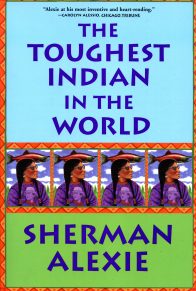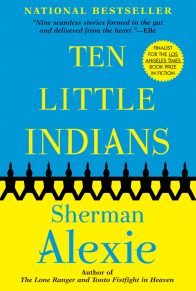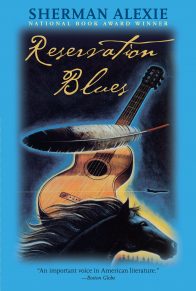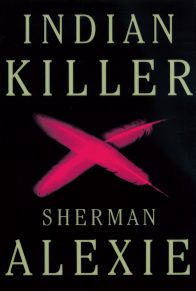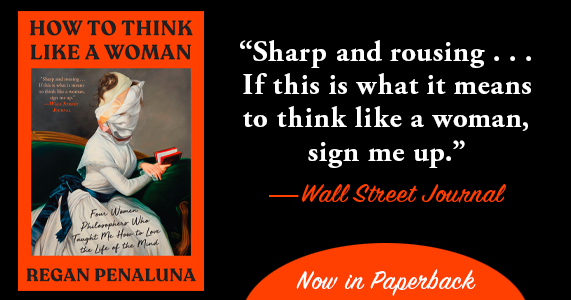1. Epigrams from Lou Reed and Joy Harjo prepare the reader’s way into the collection. What ideas do they set in motion that the stories build? What do they reflect about Sherman Alexie’s sensibility?
2. Throughout the opening story, “Every Little Hurricane,” literal and figurative references to weather weave together: there is, in fact, a storm and in the lives of the characters there is volatility, too. Tension builds between the characters and erupts violently as the storm moves through. What is created through this interworking of the literal and figurative? Through the close connecting of the natural and the human worlds?
3. In “Every Little Hurricane,” as two brothers fight and nearly murder each other, characters watch rather than act to avert a tragedy. Why don’t they intervene? Is it merely a matter of passivity? What is meant by the line “This little kind of hurricane was generic”?
4. Thomas Builds-the-Fire, the seer, becomes increasingly isolated as the stories progress. Victor says, “Hell, he looked around our world and then poked his head through some hole in the wall into another world. A better world.” Even so, Victor asks him if he really believes that shit, and others, too, resist and mock his visions. Why? How would you characterize his visions, his place on the reservation, and the nature of the threat that he poses?
5. Victor’s relationship with tradition (and Thomas) is complex. After he calls Thomas’s visions “that shit,” Thomas walks away from him—for several years, as it turns out. Big Ma, the spiritual leader of the Spokanes, gives Victor a drum—a pager, she jokes. Victor calls it the “only religion I have.” What is Victor’s relationship with religion and tradition? Why does he have a sudden need for tradition when his father dies? When they discuss tossing the ashes of Victor’s father into the Spokane Falls, Thomas imagines him rising like a salmon and Victor imagines him cleaning the attic. What do these different visions reflect about them?
6. The deep longing of young men to be warriors emerges in several stories. Why? What is the particular freight of this desire for young Indian men? What fuels their desire? What frustrates its fulfillment?
7. In “The Only Traffic Signal on the Reservation,” Alexie depicts baseball as having extraordinary significance on the reservation. With what meaning(s) is baseball invested? Why?
8. An epigram from Kafka’s The Trial introduces “The Trials of Thomas Builds-the-Fire.” What tone does the quotation set? Kafka’s sensibility, his nightmarish evocation of modern life, has inspired writers from diverse traditions. Why might Kafka be a potent reference point for Alexie? Why The Trial in particular?
9. “Distances” is a vision of Thomas’s that is framed at the culmination of “The Trials of Thomas Builds-the-Fire,” which is in itself a blend of the fantastic and the real. As we move ever more deeply into the place of vision, do we feel that we are moving away from the truth? Or closer to it? How does Alexie depict the Tribal Council? What is being explored?
10. In “Distances” the line “I dreamed of television and woke up crying” is set off and repeated. What is the importance of this line? How does it compare to the line repeated in “The Love Song of J. Alfred Prufrock”: “In the room the women come and go / Talking of Michelangelo’? How does Alexie’s line connect to the rest of the story, to its tone? How does it relate to Thomas’s vision of the Tribal Council? What would the story be like without it?
11. Profound complexities attend the characters’ lives, saddled as they are with the weight of a tragic history and the difficulties of modern Indian life. “Imagining the Reservation” ends with a series of sentences that begin imperatively—”Imagine.” What does Alexie suggest about the force and potential of the imagination for Indians?
12. In “The Approximate Size of My Favorite Tumor” Alexie calls humor “an antiseptic that cleaned out the deepest personal wounds.” How important is humor in The Lone Ranger and Tonto Fistfight in Heaven? What sort of humor prevails?
13. Throughout the stories Alexie vividly evokes the fragility of the tribal world. There is a sense that the tribe threatens to die out: “Sometimes it feels like our tribe is dying a piece of fry bread at a time.” How does this sense of threat to the culture affect the lives of the characters? How does it inform the tone of The Lone Ranger and Tonto Fistfight in Heaven?
14. Early in “Witnesses, Secret and Not” the narrator tells a story from the time when he was thirteen. He refers to the challenge of figuring out what it means to be Indian. In “Witness” he goes with his father when he is called in for questioning about an old case that involves a missing Indian. We hear that “sometimes it seems that all Indians can do is talk about the disappeared.” Why are the disappeared discussed? How does this connect to the question of Indian identity articulated early in the story?
15. In his stories Alexie frequently includes details of everyday contemporary life, with its Diet Pepsis and 7-Elevens. Why? What do these details contribute to the tone and texture of the stories?
16. On the other hand, Sherman Alexie’s use of language can trope toward the poetic, becoming lush, or sparklingly vivid, or hauntingly rhythmic. Why do his stories accommodate such play with language? When does his writing tend to become more poetic?
17. For viewers of Smoke Signals, how well do you think the movie captures the quality of the narratives in The Lone Ranger and Tonto Fistfight in Heaven?
18. Throughout these stories characters drink and are drunk. As Alexie acknowledges in his Introduction, he has been criticized for promoting the stereotype of the drunk Indian. How just is this critique? What does his underscoring of the force of drink in Indian life say about his sensibility as a writer?
19. In his Introduction Sherman Alexie confesses the largely autobiographical nature of these stories, but he also asserts that they really are not true. They are the vision of “one individual looking at the lives of his family and his entire tribe, so these stories are necessarily biased, incomplete, exaggerated, deluded, and often just plain wrong. But in trying to make them true and real, I am writing what might be called reservation realism.” He doesn’t explain ‘reservation realism,” but rather points to the stories and instructs the reader “to figure that out for yourself.” What, in fact, do you think he means by “reservation realism?”
20. Why do you think The Lone Ranger and Tonto Fistfight in Heaven has become a significant book? Are these stories important as an evocation not only of Indian life, but of American life as well?





